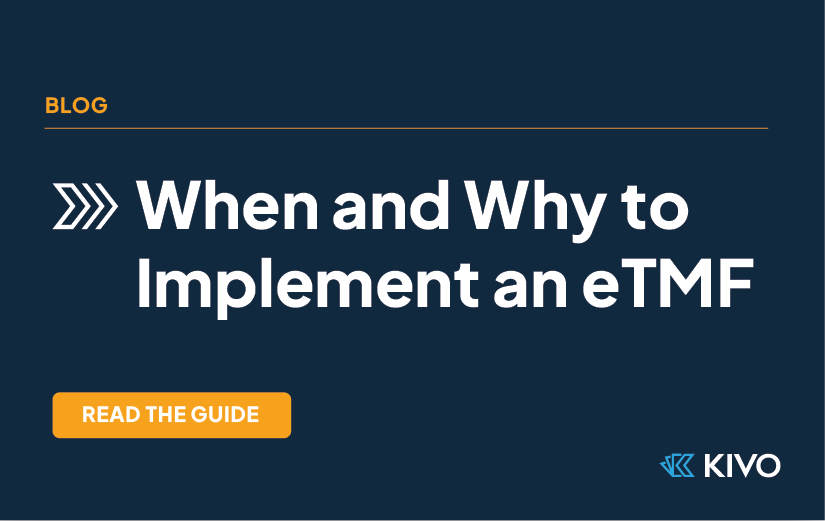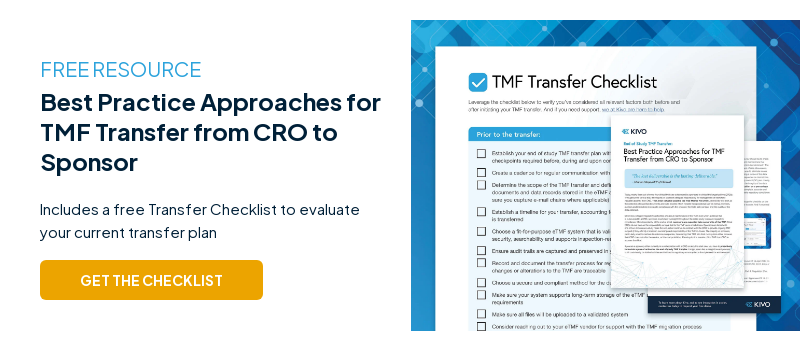When conducting clinical operations, particularly as studies progress from Phase 1 to Phase 2, the question may arise: When is the right time to integrate our own Electronic Trial Master File (eTMF) system? This article addresses the critical aspects of when and why organizations should consider implementing an eTMF, particularly focusing on the phases of clinical trials where its benefits are most pronounced.
Running and managing a clinical trial can be a daunting task, which is why so many organizations look for support and to outsource some activities. As sponsors increasingly outsource to CROs, so has using the CROs' eTMF system, rather than using an in-house solution. However, there are many benefits to bringing your TMF in house, such as improved visibility, increased control of your trial data, and mitigating the risk of data loss after the end of study transfer.
Whether you are partnering with a CRO or not, clinical study documentation and the requirements for managing content are very complex. This complexity exists during the active trial and for years (or decades) afterwards. Thus, you will need to have access to your data in an organized and secure eTMF system at SOME point. The longer you wait to migrate data into your own system, the higher the migration risk.
Do small sponsors need an eTMF System?
Absolutely. Gone are the days when having a proper eTMF system was a luxury for big pharma. As virtual inspections increase and the need for smooth End of Study transfers from Contract Research Organizations (CROs) to Sponsors gains momentum, eTMFs have transformed from being "nice to have" to becoming an indispensable tool for efficiently managing clinical study documents and inspections. After all, your data is your evidence of scientific merit. How this trial information is presented directly affects the outcome for regulatory approval.
What challenges arise without an eTMF?
Many organizations struggle with the complex requirements of managing and storing clinical trial data.
Why?
Here are some of the most common challenges we encounter:
- An incomplete understanding of the requirements around control and storage of documents, data, and correspondence
- A lack of investment into the people, processes, or tools needed to effectively manage the information
- A lack of visibility into how a third party / CRO is managing the data
Effectively managing the extensive data generated throughout the trial lifecycle necessitates robust systems and processes. Incorporating systems that streamline data collection, evaluation, and accessibility presents both a challenge and an opportunity. However, selecting the right systems and their timely implementation is pivotal, considering the intricate regulatory landscape and resource allocation constraints. Thus each organization needs to determine what factors affect their ability to bring its drug to market successfully, and align their regulatory processes, people, and tools accordingly.
How does an eTMF improve inspection outcomes?
Let’s think about what the main purpose of an eTMF really is. It is not just to store documents or data. It's actually the narrative structure of your trial that you will present to inspectors for regulatory approval.
When inspection day arrives, you want to present a clear story to your inspector. If your data is a mess - hard to access, multiple versions floating around, documents in different systems - it becomes much harder to paint a clear picture of your trial. Not to mention, if documents are mishandled along the way and the audit trail becomes broken, you risk having a poor inspection and possible delay to market..
A fit-for-purpose eTMF system not only mitigates the compliance issues, but can provide features like configurable access for inspectors, so you only present the information you want them to see, not draft documents.
So when should I implement an eTMF system?
Organizations struggle with determining the best time to take control of their documentation and implement a system. Each phase in the lifecycle of a trial brings a different set of needs and challenges. The progression of the trial increases the volume of the data, requiring more control around the documentation. That said, an eTMF system can be implemented at any stage.
Here are few questions to ask yourself to determine if it's time to consider your own eTMF software:
- Do you have any studies?
- Is your program moving into the IND phase?
- Has your study progressed beyond Phase 1 – Safety?
- Will any of the studies be part of an inspection?
- Do any of your studies have more than one country involved?
- Are there components of your trial in Europe or the UK?
- What does your budget look like? Financial implications should not just be considered during the study, but the cost to transfer your study also should be considered.
Overall, the sooner you invest in an eTMF to support your studies the more compliant you will be, and it will help streamline the entire process. If you choose to wait and think lacking an eTMF will not affect the overall inspection, you may experience an unwelcome surprise.
How to choose an eTMF System
Given its importance, the choice of what eTMF software to use is a big decision! We have written a short guide to help you evaluate eTMF providers, but in summary:
- Make sure it includes essential features such as document management, follows relevant compliance requirements such as CFR Part 11, and leverages best practices in security such as single-sign on or SOC 2 certifications.
- Evaluate the vendor themselves. Your eTMF vendor should feel like a partner - someone you can rely on for guidance and support when you need it.
- Understand the all-in cost of the system, including implementation fees, migration fees, per study fees, etc. Make sure you have a clear understanding of how the cost will grow if you scale.
Conclusion
Having an eTMF to manage trial documents should not be delayed or put off until the end of a study. Even if you are using a CRO's system as your primary eTMF, you are regulatory generating documents that should be in a controlled system at all times. If you have not considered implementing an eTMF for your clinical trial documents, now is a good time to begin the process of evaluating and implementing a system.




